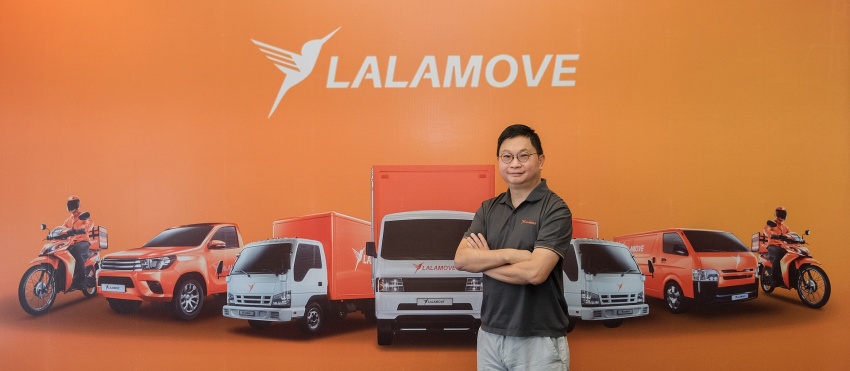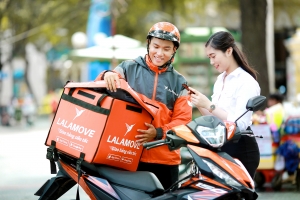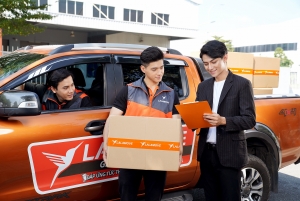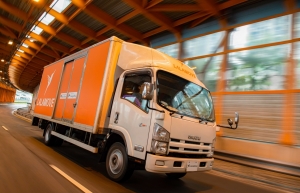Lalamove plans to boost presence in Vietnam
What are the highlights of Lalamove’s performance over the past two years? How can the company support businesses, especially small- and medium-sized enterprises (SMEs), to maximise their budget?
We have been trying to be highly flexible for the last few years. The different types of vehicles that we have and the sheer volume of driver partners that we have helped us to fill a vital logistics role during COVID-19.
We've managed to scale up in a short period of time so that we can serve needs during the pandemic, whether it's lock down or when the economy is not strong. You can imagine over the last couple of years, people have stayed home a lot and require delivery service. And as a result, we had a crew and an active user base of more than 160 per cent over the last two years.
 |
| Paul Loo, COO Lalamove |
But now, with COVID behind us, we are in recovery mode. If I'm running an SME, I will be very cautious about the type of investment because things are a bit uncertain. And instead of investing in my own fleet or drivers, I can make use of platforms like Lalamove to grow my business without much fixed-cost investment. So, with that, we are recovering together with the SMEs.
If you look at the entire time window over the last three years, it proves how resilient our business model is. And in particular, we have requests from many of our users who want to expand with us. That's why we have started to get into long-distance intercity delivery. It is overall still a small proportion of our business. But it is growing very fast.
In Vietnam, we had around 70 to 80 per cent of our business coming from SMEs. There is a mixture. Some are last-mile delivery to the consumer, but some are mid-miles from warehouses to branches.
But some of the markets are the exact opposite, like in Thailand, about 60-70 per cent of the business is to consumers. So what's more important is we have all types of vehicles to serve different purposes, sizes or delivery.
We make considerable investments in technologies, both in terms of talent and our spending on the technology itself. Other technologies are more specific to our industry, like payment, antifraud, big data, and machine learning.
Drivers play essential roles in the delivery industry. How has Lalamove maintained the "win-win" philosophy among them and a strong, dense network of drivers to meet demand?
It is pretty straightforward: drivers look forward to taking more orders and increasing income. That’s our number one priority to help them up, so that is why we will invest a lot in generating demand, investing a lot in introducing our business model to potential users, and making our vehicle available to them. This is how we invest in our demand side, so there will be more orders for driver-partners to take.
On-demand delivery continues to improve every day. Schedule delivery is a different game, the features it takes, the type of business development team we need and how we understand the users' requirements.
Traditional instant delivery point-to-point delivery requires the tech can do the instant matching as soon as possible. Schedule delivery allows us to use the tech to improve efficiency. For example, because we know about the amount and origin and destination in advance, we can make use of our route optimising features to plan the routing for our driver-partners
That can help to improve the efficiency of the delivery by using the least number of vehicles to do the most number of stops, will reduce the logistic cost for users, improve the drivers’ income, and is suitable for the environment.
Scheduled delivery, compared with instant delivery, is relatively new to us, but in the coming year, you will see more new features rolling out to help users with scheduled delivery needs.
Fuel cost has increased significantly and affected business activities. How can Lalamove ensure that the company delivers affordable services?
The impact of fuel cost, especially pressure due to inflation, is affecting everyone, affecting the cost of operation of the driver partners and the cost of doing business for our SME users. As a platform, what we can do is continue to invest in our tech so to make the matching more and more efficient every day.
In addition to that, there are specific things that we have done for the driver-partners and the users to help them. For example, on the user side, we launched our Lalamove reward program slightly more than a year ago. We launched it in Vietnam as well. The response has been very good. We have more than half a million members worldwide already. And that will give users an incentive to keep placing orders through our platform.
And on the driver partner side, we also roll out the driver partners protection insurance program in all the markets in Asia to help protect our driver partners. So it is not an accessible external economic environment, but by sticking to the triangular relationship, hopefully, all three parties can win together.
Just think about it if you're the user, you can match the vehicle you need in 30 seconds, and as the driver, you open up the apps, and there are nearby orders for you to take. Together with the local team that we are building, we have roughly 200 staff in Vietnam. We see this is how we contribute to the local economy.
What are Lalamove’s long-run and short-term targets to better meet on-demand logistics services and increase its footprint in Vietnam?
Because of our global and around-the-clock operations, we have our data centre in Singapore with Amazon and another data centre covering our Latin America operations. Google is one of the map suppliers that we use. So that's the type of investment we are making in technology.
We are doing some in-house app development that is very specific to what we do. We are working at the moment to develop safety-related applications that can make use of the data we collect so that we can help our driver partners to drive safely and fuel efficiently. This is the typical way we use the data to make life easier for our driver partners.
Imagine if you are the driver partner, thanks to the algorithm that we use, you will see more and more orders near you so that the spare time between delivery orders will be shorter and shorter. That helps even though the fuel price is not low. Our development impact is typical to improve the efficiency of matching, the livelihood of the driver partners and the order-placing experience of the users.
We continue to improve and do better so our driver-partners can earn more income, and our business users can reduce their logistic costs while improving our technology system, optimise our operation team to ensure everything is the best service for our users, and also the chances for driver-partners to improve their income.
 | Lalamove adjusts fares to share difficulties with customers While ride-hailing and food delivery service providers hiked fees and commission rates, triggering concerns among drivers and passengers, Lalamove is adjusting fees to benefit customers. |
 | Lalamove ramps up truck delivery services in Vietnam On-demand delivery platform Lalamove has stepped up its inner-city truck delivery services to meet the rising demand for last-mile delivery by companies, organisations, and individuals in the peak season. |
 | Lalamove empowers SMEs with fast delivery services On-demand delivery platform Lalamove is providing fast delivery services from motorbikes to trucks to serve small- and medium-sized enterprises across Vietnam. |
What the stars mean:
★ Poor ★ ★ Promising ★★★ Good ★★★★ Very good ★★★★★ Exceptional
Related Contents
Latest News
More News
- Climate Finance Accelerator Vietnam begins search for projects seeking investment (December 18, 2025 | 17:22)
- Vietnam and Switzerland conclude SwissTrade (December 17, 2025 | 18:22)
- TECHFEST Vietnam 2025 links startups with policy and capital (December 15, 2025 | 18:21)
- MST to allocate $3.8 billion for sci-tech in 2026 (December 15, 2025 | 18:10)
- Long Thanh International Airport welcomes first Vietnam Airlines test flight (December 15, 2025 | 18:01)
- Health Innovation Hub: accelerating health equity through digital healthcare innovation (December 15, 2025 | 08:00)
- Vietnam’s first AI Law to take effect from March 2026 (December 12, 2025 | 09:00)
- Chi Communications joins SEA CAN alliance (December 11, 2025 | 17:39)
- New Law on High Technology sets incentives and safeguards (December 11, 2025 | 09:00)
- IBTE 2025 to return to Ho Chi Minh City this December (December 11, 2025 | 09:00)

 Tag:
Tag:


























 Mobile Version
Mobile Version